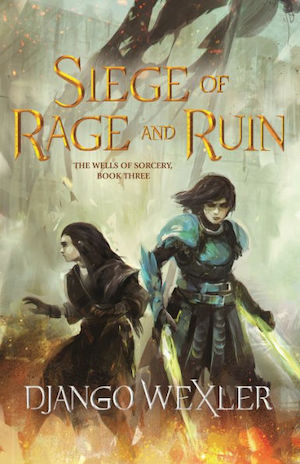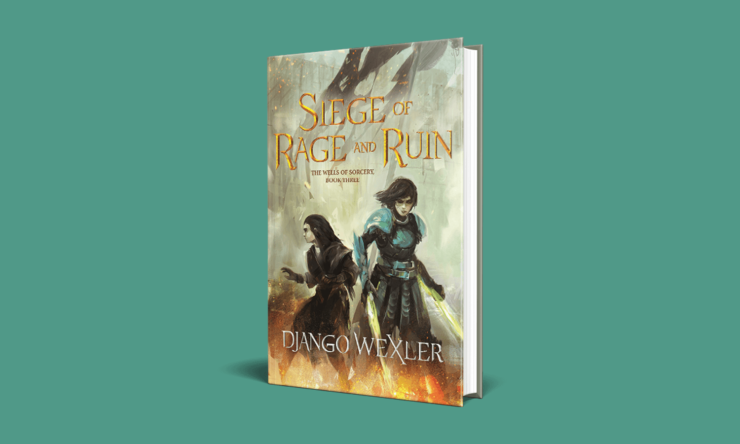In the final installment of the Wells of Sorcery series, author Django Wexler has brought both of his characters together for a climactic story of injustice, oppression, power, and leadership.
From page one of Siege of Rage and Ruin, Wexler sets us up for an explosive reunion as sisters Isoka and Tori, separated by miles of ocean for two books, but united in blood and righteousness, must reckon with each other and figure out a way forward before Naga takes them and everything they love to the grave.
Gelmei Isoka, the Deepwalker, wielder of the Wells of Melos and Eddica, War and Spirit, is on her way back to Kahnzoka, intent on rescuing her sister Tori from the razor-sharp promise of Kuon Naga, ruler in all but name of the city and its army of Immortals. Gelmei Tori, however, is not sitting up in her tower hidden away, not anymore. After the events of book two, Tori is now the de facto leader of the Red Sashes, rebels who oppose Kuon Naga and his brutal reign over the city and its mage-blooded who he conscripted into service, producing more mage-bloods by birth or fighting for the city. A user of Kindre, the Well of the Mind, Tori has used her psychic powers in ways that haunt her, but she cannot back down and fail the rebellion she helped start.
While book three delivers on action, I was far more interested in how satisfying it was thematically. Book one, Ship of Smoke and Steel, focused on Isoka, cruel and hard and thinking that’s all she could ever be. Forced aboard Soliton, the ghost-ship that Kuon Naga wanted her to steal, she rose in the ranks, discovered her ability to talk to the dead, and learned how to let her walls down, not just falling in love with the princess Meroe, but assuming leadership and caring those others aboard the ship. Book two, City of Stone and Silence, tested both Isoka and Tori: Isoka had leadership, but could she keep it? Could she truly learn to lead and let others help or decide actions for themselves? Likewise, Tori saw the truth of her city, and learned very hard lessons about the nature of power, who wielded it, and who was crushed by it, finding leadership for herself, while grappling with the actions she had to take to defend herself and her cause. And here, we finally come full circle: both sisters have learned how to lead under terrible situations, have had to make choices that haunt them. And in seeing the changes in each other, in seeing the near-futility of a rebellion almost designed to fail, they have to ask: if the right thing to do is going to fail, is it still worth doing?
Buy the Book


Siege of Rage and Ruin
Each sister has a different answer to that question and that’s the core of the novel to me. Don’t get me wrong, there is action a-plenty and Wexler has never been more at the top of his game: the mixture of high stakes combat, combined with deep worldbuilding, stakes being cranked higher and higher with each chapter, happening side by side by deep character work, questions of morality, philosophy, and the grey areas that leaders such as the Gelmei sisters must ask themselves…it is a tightwire act that seems effortless in its balancing, but speaks to just how good Wexler is at this. Being the third book, there are a few worldbuilding reveals here and there that just made me grin from ear to ear, some surprising ways that Wells can work together, and some twists and turns that fans of the first two books will be shouting to see. And with such effort in books one and two done, the reader can sit back and watch Wexler put our heroes through the ringer, giving them one final push before the end.
Can Isoka stay as cruel and ruthless as she used to be, coming home to the city that made her, when all she can think of is the cost of bloodshed, when all she wants is to run away with her girlfriend and love her without worrying about war? Can Tori forgive herself for doing what she had to, the brutal ways she’s twisted people’s minds to protect her rebellion and the rebels who look to her, when all she wants is to bury herself deep, thinking she’s nothing but a monster? The sisters grapple with their issues, yes, but their answers are to be found by trusting in each other. Wexler makes no subtlety about how much war, oppression, pain, and injustice can weigh on those fighting to overturn them, and the costs associated with such a course of action. It will always be worth standing up to those who would put you in the mud and have power over you, but Wexler interrogates through the Gelmei sisters what the costs of that could be and what happens when you’re the one making those calls.
By the end of the book, I was filled with a bittersweet feeling, a very good sign of the overall strength of this wonderful trilogy. A strong young adult fantasy series, with excellent, intriguing worldbuilding, complex, queer characters, and strong themes that echoed in my mind long after the close of each book, Wexler nails the landing not just for Siege of Rage and Ruin but for the whole of the Wells of Sorcery trilogy. I’ll be sad to see Isoka and Meroe and Tori go, their friends and enemies with them, but I cannot help but be grateful for the time we had with them. Wexler, no matter the genre, delivers some damn good stories, and I’m eagerly awaiting what’s next for him.
Siege of Rage and Ruin is available from Tor Teen.
Martin Cahill is a writer living in Queens who works as the Marketing and Publicity Manager for Erewhon Books. He has fiction work forthcoming in 2021 at Serial Box, as well as Beneath Ceaseless Skies and Fireside Fiction. Martin has also written book reviews and essays for Book Riot, Strange Horizons, and the Barnes and Noble SF&F Blog. Follow him online at @mcflycahill90 and his new Substack newsletter, Weathervane, for thoughts on books, gaming, and other wonderfully nerdy whatnots.










